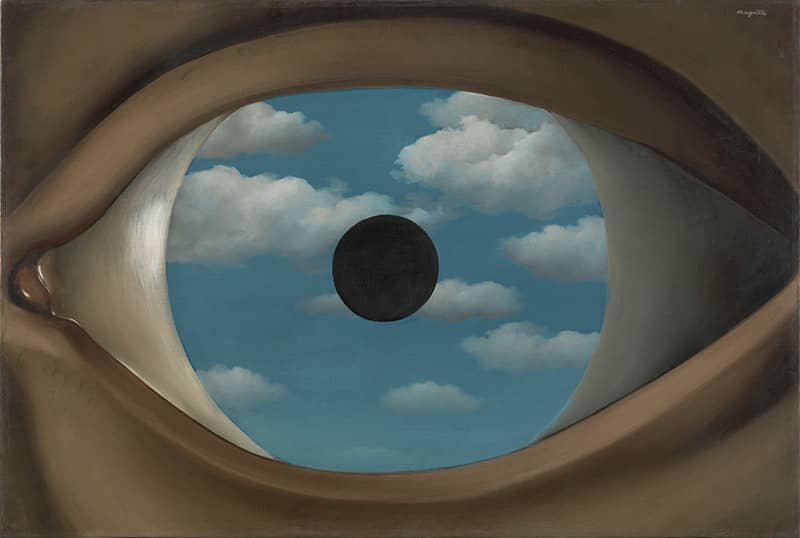Awareness - the bridge between sensation and action
René Magritte: ‘The False Mirror’
"Awareness is the spontaneous sensing of the whole situation in which we find ourselves."
– Claudio Naranjo
The Gestalt Contact Cycle – Awareness
In the first post of this series, I explored the fertile void, the still and unformed space from which all creative contact emerges. In the second post, I turned to sensation, the stage where the vague stirrings of the void become tangible—where the body begins to notice and respond to stimuli. Now, we move to the third stage of the Gestalt contact cycle: awareness.
Sensation is the raw material of experience, but awareness is where meaning begins to form. It is the moment when sensations crystallize into something we can recognize, name, and explore. As Fritz Perls explains, "without awareness, we are not really alive; we are automatons, carrying out habitual routines." To fully inhabit this stage is to connect deeply with the present moment and to allow needs and possibilities to emerge into clarity.
From Sensation to Awareness
The transition from sensation to awareness is subtle but profound. Imagine feeling a vague tightness in your chest—a sensation. As you stay with it, perhaps it sharpens into an emotion, such as anxiety, or a physical need, like hunger. Awareness transforms this indistinct bodily signal into a recognizable figure in your inner world. Only through this process can we begin to respond to our needs intentionally, rather than reactively or unconsciously.
Gary Yontef, in Awareness, Dialogue, and Process, describes awareness as “a form of experiencing in which a person stands back and observes, identifies, and makes meaning of what is happening.” It is not just passive observation but a dynamic engagement with the self and the environment. Awareness anchors us in the present, allowing us to connect sensation with context and need with possibility.
Awareness of Need: Challenges and Polarities
Awareness of need lies at the heart of the contact cycle, yet it can be fraught with challenges. At one end of the spectrum, we may avoid awareness through deflection. This can manifest as distraction, intellectualization, or dismissing a need as unimportant. For instance, you might feel a nagging dissatisfaction but turn to scrolling on your phone rather than exploring the discomfort.
On the other end of the polarity is being mesmerized by a need, becoming so consumed by it that it overwhelms other aspects of awareness. This might look like obsessing over a craving or desire, unable to step back and consider alternatives. Both deflection and mesmerization interrupt the balanced, dynamic flow of awareness.
The middle ground is clear, grounded awareness—a state in which we recognize a need, understand its significance, and remain open to exploring how best to meet it. For example, acknowledging a longing for connection might lead to thoughtfully reaching out to a friend, rather than numbing yourself with distractions or fixating on feelings of loneliness.
Artistic Explorations of Awareness
Art and music offer powerful metaphors for awareness and its nuances. Take René Magritte’s The False Mirror. This surrealist painting, depicting an eye reflecting a vast sky, invites the viewer into a space of ambiguity and introspection. Is the eye perceiving the world, or is it consumed by it? This mirrors the balance between deflection and mesmerization: the challenge of staying open to perception without losing oneself in it.
In music, Philip Glass’s minimalist compositions, such as Glassworks, exemplify the practice of sustained, focused awareness. The repeating, evolving patterns demand attentive listening, encouraging the listener to notice subtle variations and shifts. It is an invitation to stay present, neither distracted nor overwhelmed.
Cultivating Awareness
Awareness is not a static state but a living, dynamic process. It requires curiosity, courage, and compassion. Practices like mindfulness, journaling, or engaging in dialogic relationships, can help us deepen awareness, fostering the ability to notice emerging figures of need while remaining connected to the broader context of our lives.
In Gestalt therapy, the therapist and client collaborate to cultivate awareness, creating a space where needs and sensations can surface and be explored without judgment. This process invites clients to engage with their experience fully, laying the groundwork for meaningful action and connection.
As we move through the contact cycle, awareness is the bridge between sensation and action, where we transform raw experience into clarity and intention
Take a moment to pause and reflect. What sensations are present for you right now? How might they be developing into awareness? Explore this process with a piece of music or spend time with a contemplative artwork. Notice how your sensations and thoughts shift as you deepen your awareness.
In the next post, I’ll explore mobilisation, the stage where awareness begins to translate into action. For now, rest in the richness of awareness—a space where presence transforms potential into possibility.
